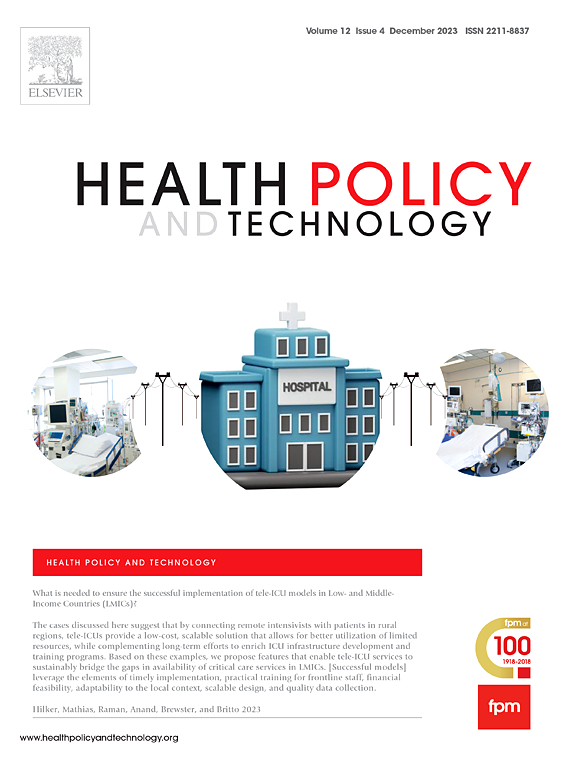Wearable devices and physical activity disparities: Insights from the 2022 Health Information National Trends Survey
IF 3.4
3区 医学
Q1 HEALTH POLICY & SERVICES
引用次数: 0
Abstract
Objective
This study aimed to investigate the association between wearable device use and physical activity, as well as to assess the mediating role of wearable device use in the relationship between social disparities and achievement of recommended level of physical activity.
Methods
Data from the 2022 Health Information National Trends Survey (HINTS 6) (n = 4922) were analyzed. Weighted prevalence estimates were presented, and adjusted odds ratios from multivariable logistic regression of wearable device use and meeting recommended levels of physical activity were reported. Causal mediation analysis (CMA) was conducted to examine the mediation effect of sociodemographic factors on physical activity via wearable devices.
Results
Among participants, 34.9 % used wearable devices, and 37.1 % achieved the recommended level of 150 min of weekly moderate-intensity physical activity. Wearable device users were 1.84 times more likely to achieve recommended physical activity goals than non-users. Significant mediation effects of wearable device use were found, mediating the association between female sex and higher education attainment with physical activity. Furthermore, among wearable users, Asians, and individuals with a body mass index ≥ 30 kg/m2 were less likely to meet recommended levels of physical activity.
Conclusions
Wearable device use exhibit sociodemographic patterns, influencing physical activity and potentially exacerbating health disparities. Promoting equitable usage of wearables and enhancing skills in utilizing wearable devices can significantly enhance physical activity levels, playing a pivotal role in reducing health disparities and fostering overall well-being.
可穿戴设备和身体活动差异:来自2022年健康信息全国趋势调查的见解
目的探讨可穿戴设备使用与身体活动的关系,并评估可穿戴设备使用在社会差异与达到推荐身体活动水平的关系中的中介作用。方法对2022年健康信息全国趋势调查(HINTS 6)的数据(n = 4922)进行分析。提出了加权患病率估计,并报告了可穿戴设备使用和达到推荐体力活动水平的多变量logistic回归的调整优势比。采用因果中介分析(CMA)检验社会人口学因素对可穿戴设备运动的中介作用。在参与者中,34.9%的人使用可穿戴设备,37.1%的人达到了每周150分钟中等强度体力活动的推荐水平。可穿戴设备用户达到推荐运动目标的可能性是非用户的1.84倍。可穿戴设备的使用在女性性别、高等教育程度与体育活动之间具有显著的中介作用。此外,在可穿戴设备用户中,亚洲人和体重指数≥30 kg/m2的个体不太可能达到推荐的身体活动水平。结论可穿戴设备的使用表现出社会人口统计学模式,影响身体活动并可能加剧健康差距。促进可穿戴设备的公平使用和提高使用可穿戴设备的技能,可以显著提高身体活动水平,在缩小健康差距和促进整体福祉方面发挥关键作用。
本文章由计算机程序翻译,如有差异,请以英文原文为准。
求助全文
约1分钟内获得全文
求助全文
来源期刊

Health Policy and Technology
Medicine-Health Policy
CiteScore
9.20
自引率
3.30%
发文量
78
审稿时长
88 days
期刊介绍:
Health Policy and Technology (HPT), is the official journal of the Fellowship of Postgraduate Medicine (FPM), a cross-disciplinary journal, which focuses on past, present and future health policy and the role of technology in clinical and non-clinical national and international health environments.
HPT provides a further excellent way for the FPM to continue to make important national and international contributions to development of policy and practice within medicine and related disciplines. The aim of HPT is to publish relevant, timely and accessible articles and commentaries to support policy-makers, health professionals, health technology providers, patient groups and academia interested in health policy and technology.
Topics covered by HPT will include:
- Health technology, including drug discovery, diagnostics, medicines, devices, therapeutic delivery and eHealth systems
- Cross-national comparisons on health policy using evidence-based approaches
- National studies on health policy to determine the outcomes of technology-driven initiatives
- Cross-border eHealth including health tourism
- The digital divide in mobility, access and affordability of healthcare
- Health technology assessment (HTA) methods and tools for evaluating the effectiveness of clinical and non-clinical health technologies
- Health and eHealth indicators and benchmarks (measure/metrics) for understanding the adoption and diffusion of health technologies
- Health and eHealth models and frameworks to support policy-makers and other stakeholders in decision-making
- Stakeholder engagement with health technologies (clinical and patient/citizen buy-in)
- Regulation and health economics
 求助内容:
求助内容: 应助结果提醒方式:
应助结果提醒方式:


